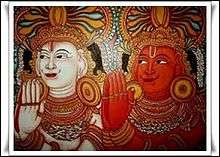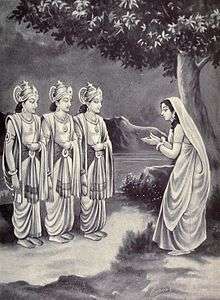Aśvins
The Aśvins, or Ashwini Kumaras (Vedic Sanskrit: अश्विन्, aśvin, dual aśvinau; "horse possessors"; also spelled Ashvins),[1] are twin Vedic gods of medicine in Hindu mythology. Associated with the dawn, they are described as youthful divine twin horsemen in the Rigveda, travelling in a chariot drawn by horses that are never weary.[2]
| Aśvins | |
|---|---|
Gods of Health and Medicine; The Divine Physicians of the Gods | |
 Ashwini Kumaras - Nasatya and Dasra | |
| Affiliation | Devas |
| Mount | Golden Chariot |
| Personal information | |
| Parents | Saranyu and Surya |
| Siblings | Yamraj, Yami, Revanta |
| Consort | Wife of Nasatya: Jyoti (Goddess of the human body) Wife of Dasra : Mayandri (Goddess of Magic) |
| Children | Nasatya's son : Satyavir (god of recovery) Nakula ( spiritual son) Dasra's son : Damraj (god of leaves) Sahadeva (spiritual son) |
Origin
The Aśvins are an instance of the Proto-Indo-European divine horse twins.[3][4][2] Reflexes in other Indo-European mythologies include the Baltic Ašvieniai, the Greek Castor and Polux; and possibly the English Hengist and Horsa, and the Welsh Bran and Manawydan.[3] The first mention of the Nasatya twins is from the Mitanni documents of the second millennium BCE, where they are invoked in a treaty between Suppiluliuma and Shattiwaza, respectively kings of the Hittites and the Mitanni.[5]
Names

In the Rigveda, the Aśvins are always referred to in the dual, and do not have individual names,[2] although Vedic texts differentiate between the two Aśvins: "one of you is respected as the victorious lord of Sumakha, and the other as the fortunate son of heaven" (RV 1.181.4). They are called several times divó nápātā, "sons of Dyaús (the sky-god)".[6]
The twin gods are also referred to as Nā́satyā (possibly "saviours"; a derivate of nasatí, "safe return home"), a name that appears 99 times in the Rigveda.[6] The epithet probably derives from the Proto-Indo-European root *nes- ("to return home (safely)"), with cognates in the Avestan Nā̊ŋhaiθya, the name of a demon, as a result of a Zoroastrian religious reformation that degraded the status of prior deities, in the Greek hero Nestor, and in the Gothic verb nasjan ("save, heal").[1][7]
Role
The Aśvins are often associated with rescuing mortals and bringing them back to life.[1] Rebha was bound, stabbed, and cast into the waters for nine days and ten nights before being saved by the twins. He was explicitly described as "dead" (mamṛvā́ṃsam) when the twins "raised (him) up" (úd airayatam) to save him (RV 10.39.9). Similarly, Bhujyu was saved after his father or evil companions abandoned him at sea, when the twins “[brought] (him) home from the dead ancestors” (niváhantā pitṛ́bhya ā́, 1.119.4).[1] The Rigveda also describes the Aśvins as "bringing light": they gave "light-bringing help" (svàrvatīr…ūtī́r, 1.119.8) to Bhujyu, and "raised (Rebha) up to see the sun" (úd…aírayataṃ svàr dṛśé, 1.112.5).[1][2]
The Aśvins are invoked at dawn, the time of their principal sacrifice, and have a close connection with the dawn goddess, Uṣas: she is bidden to awaken them (8.9.17), they follow her in their chariot (8.5.2), she is born when they hitch their steeds (10.39.12), and their chariot is once said to arrive before her (1.34.10).[1] They are consequently associated with the "return from darkness": the twins are called “darkness slayers” (tamohánā, 3.39.3), they are invoked with the formula "you who have made light for mankind" (yā́v…jyótir jánāya cakráthuḥ, 1.92.17), and their horses and chariot are described as "uncovering the covered darkness" (aporṇuvántas táma ā́ párīvṛtam, 4.45.2).[1]
_LACMA_M.83.1.7_(1_of_2).jpg)
Rigveda
The Aśvins are mentioned 398 times in the Rigveda,[1] with more than 50 hymns specifically dedicated to them: 1.3, 1.22, 1.34, 1.46–47, 1.112, 1.116–120, 1.157–158, 1.180–184, 2.20, 3.58, 4.43–45, 5.73–78, 6.62–63, 7.67–74, 8.5, 8.8–10, 8.22, 8.26, 8.35, 8.57, 8.73, 8.85–87, 10.24, 10.39–41, 10.143.[2]
Your chariot, o Aśvins, swifter than mind, drawn by good horses, comes to the clans.
By which (chariot) you go to the home of the good ritual performer, by that, o men, travel your course to us.
You free Atri, the seer of the five peoples, from narrow straits, from the earth cleft along with his band, o men—confounding the wiles of the merciless Dasyu, driving them out, one after another, o bulls.
O Aśvins—you men, you bulls—by the wondrous powers you draw back together the seer Rebha, who bobbed away in the waters, like a horse hidden by those of evil ways. Your ancient deeds do not grow old.
Role in Mahabharata
Indian holy books like the Mahabharata and the Puranas, relate that the Ashwini Kumar twins, who were Raja -Vaidya (royal physicians) to the Devas during Vedic times, first prepared the Chyawanprash formulation for Rishi Chyavana at his Ashram on Dhosi Hill near Narnaul, Haryana, India, hence the name Chyawanprash.[9] In the epic Mahabharata, King Pandu's wife Madri is granted a son by each Ashvin and bears the twins Nakula and Sahadeva who, are known as the Pandavas.[10]
References
- Frame 2009.
- West 2007, p. 187.
- Mallory & Adams 2006, p. 432.
- Puhvel, Jaan (1987). Comparative Mythology. Baltimore, Maryland: Johns Hopkins University Press. pp. 58–61. ISBN 0-8018-3938-6.
- KBo 1 1. Gary M. Beckman (1 January 1999). Hittite Diplomatic Texts. Scholars Press. p. 53.. Excerpt http://www.heritageinstitute.com/zoroastrianism/ranghaya/suppiluliuma_shattiwaza_treaty.htm
- Parpola 2015, pp. 109–110.
- Ahmadi, Amir (2015). "Two Chthonic Features of the Daēva Cult in Historical Evidence". History of Religions. 54 (3): 348. doi:10.1086/679000. ISSN 0018-2710. JSTOR 10.1086/679000.
- Jamison, Stephanie W. (2014). The Rigveda: The Earliest Religious Poetry of India. Oxford University Press. pp. 272–273. ISBN 9780199370184.
- Panda, H; Handbook on Ayurvedic Medicines With Formulae, Processes And Their Uses, 2004, p10 ISBN 978-81-86623-63-3
- Hindu World: An Encyclopedic Survey of Hinduism. Volume II M-Z. Benjamin Walker. Routledge. 2019. Entry: "Pandava"
Bibliography
- Frame, Douglas (2009). "Hippota Nestor - 3. Vedic". Center for Hellenic Studies.CS1 maint: ref=harv (link)
- Mallory, James P.; Adams, Douglas Q. (2006). The Oxford Introduction to Proto-Indo-European and the Proto-Indo-European World. Oxford, England: Oxford University Press. ISBN 978-0-19-929668-2.CS1 maint: ref=harv (link)
- Parpola, Asko (2015). The Roots of Hinduism: The Early Aryans and the Indus Civilization. Oxford University Press. ISBN 978-0-19-022693-0.CS1 maint: ref=harv (link)
- West, Martin L. (2007). Indo-European Poetry and Myth. Oxford University Press. ISBN 978-0-19-928075-9.CS1 maint: ref=harv (link)
Further reading
- Parva, Paushya. "Section III (Paushya Parva". Sacred Texts. pp. 32–33. Retrieved 1 November 2013.CS1 maint: ref=harv (link)
- Dictionary of Hindu Lore and Legend (ISBN 0-500-51088-1) by Anna L. Dallapiccola
- BOSCH, F. D. K. "DE AŚVIN-GODEN EN DE EPISCHE TWEELINGEN IN DE OUDJAVAANSE KUNST EN LITERATUUR." Bijdragen Tot De Taal-, Land- En Volkenkunde 123, no. 4 (1967): 427-41. Accessed June 23, 2020. www.jstor.org/stable/27860895.
- Chakravarty, Uma. “THE AŚVINS: AN INCARNATION OF THE UNIVERSAL TWINSHIP MOTIF.” Annals of the Bhandarkar Oriental Research Institute, vol. 70, no. 1/4, 1989, pp. 137–143. JSTOR, www.jstor.org/stable/41693465. Accessed 28 Apr. 2020.
- JAMISON, S. W. Indo-Iranian Journal, vol. 45, no. 4, 2002, pp. 347–350. JSTOR, www.jstor.org/stable/24664156. Accessed 28 Apr. 2020.
- Mitra, Jyotir. “ASHVINS, THE TWIN CELESTIAL PHYSICIANS, AND THEIR MEDICAL SKILL.” Proceedings of the Indian History Congress, vol. 45, 1984, pp. 220–228., www.jstor.org/stable/44140202. Accessed 28 Apr. 2020.
- Parpola, Asko. (2015). The Aśvins as Funerary Gods. In: The Roots of Hinduism. pp. 117-129. 10.1093/acprof:oso/9780190226909.003.0011.
